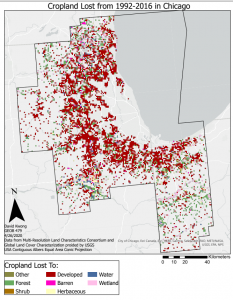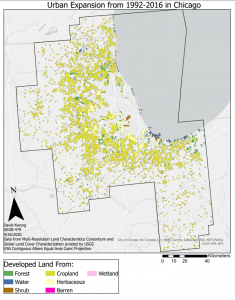Land Cover Change

Figure 4: Cropland Lost from 1992 to 2016
Cropland loss has occurred throughout the Chicago metro area, but is concentrated in a ring around the urban core. Near the urban core cropland loss is predominantly to developed land. Cropland lost to forest is scattered throughout the suburbs, but increases in frequency as you move away from the city center to more rural areas. Cropland lost to wetlands happens near lakes and rivers in the area, but not Lake Michigan. Cropland lost to herbaceous is most common in the south of the Chicago metro area, but is also scattered throughout. Overall, it is unclear whether developed, forest, or wetland are the most common land cover cropland is lost to (Figure 4).

Figure 5: Cropland gained from 1992 to 2016
Compared to cropland lost, very little cropland was gained from 1992 to 2016. There is no obvious spatial pattern aside from a cluster of forest to cropland at the eastern edge of the metro area. The most common transitions appear to be forest, urban, and water to cropland (Figure 5).

Figure 6: Developed land gained from 1992-2016
The developed or urban land gained shows a similar relationship as for cropland lost. Urban land has expanded in a ring out from the urban core in 1992, supporting the discussed trend of suburbanization (Kuang et al., 2014). Urban expansion is sparser in the more rural areas, but still evenly distributed across the metro area. The majority of developed land was gained from cropland and developed land from cropland was concentrated near the urban core. Similarly, almost all of the developed land from herbaceous land was clustered directly adjacent to existing developed land. Interestingly, some urban land was gained from water over Lake Michigan. This land filling is clustered at the southern tip of the lake where a lot of railroads, industry, and shipping is located (Figure 6).
In 1992 Chicago was surrounded predominantly by cropland (Figure 2.2), so it makes sense that the majority of urban expansion has consumed cropland over any other land cover class (Figure 6). However, while the majority of developed land is gained from cropland, the majority of cropland is lost to developed, forest, and wetland (Figure 5). This means that urbanization is an important driver of cropland lost because the majority of urban development is done at the expense of cropland. However, at the scale of the metro area, developed, forested, and wetland are replacing cropland at similar rates.